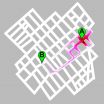The therapy helped children improve their language skills, an area of deficiency in autism, according to the study, which will be published Oct. 27 in the Journal of Child Psychology and Psychiatry. The study is the first randomized, controlled trial to test whether group classes are a good way to train parents on using an autism therapy.
"We're teaching parents to become more than parents," said the study's lead author, Antonio Hardan, MD, professor of psychiatry and behavioral sciences, who directs the hospital's Autism and Developmental Disabilities Clinic. "What we're most excited about is that parents are able to learn this intervention and implement it with their kids."
The treatment is not intended to replace autism therapies administered by professionals, but rather to improve parents' ability to help their children learn from everyday interactions.
"There are two benefits: The child can make progress, and the parents leave the treatment program better equipped to facilitate the child's development over the course of their daily routines," said study co-author Grace Gengoux, PhD, clinical assistant professor of psychiatry and behavioral sciences and a psychologist specializing in autism treatment at the hospital. "The ways that parents instinctually interact with children to guide language development may not work for a child with autism, which can frustrate parents. Other studies have shown that learning this treatment reduces parents' stress and improves their happiness. Parents benefit from knowing how to help their children learn."
Rewarding the Child
The therapy used in the 12-week study, called pivotal response training, has been shown in previous studies to help children with autism. To use the treatment for building language skills, parents identify something the child wants and systematically reward the child for trying to talk about it. For instance, if the child reaches for a ball, the parent says, "Do you want the ball? Say 'ball.'"
"The child might say 'ba,' and you reward him by giving him the ball," Hardan said. "Parents can create opportunities for this treatment to work at the dinner table, in the park, in the car, while they're out for a walk."
The method has roots in other behavioral therapies for autism, such as applied behavior analysis, but is more flexible than many such programs and makes greater use of the child's own interests and motivations.
Fifty-three children with autism and their parents participated in the study. The children ranged in age from 2 to 6. All had language delays. The parents were randomly assigned to one of two groups: The experimental group attended 12 weeks of classes on pivotal response training, and the control group attended a 12-week program offering basic information about autism.
The children's verbal skills were measured at the start of the study, at six weeks and at 12 weeks. At six and 12 weeks, the parents in the experimental group were video-recorded while using pivotal response training so that researchers could assess whether they were using the treatment correctly.
At the end of the study, 84 percent of parents who received instruction in pivotal response training were using the therapy correctly. Their children showed greater gains in language skills — both in the number of things they said and in their functional use of words — than children in the control group.
Empowering Parents
The researchers were encouraged to see that the group-based approach to training parents was successful and produced results quickly for the children. Rising rates of autism diagnosis have made it difficult for clinicians to meet the demand for their expertise, and groups are an efficient way to train parents. Parents also liked having the opportunity to learn from one another.
"Parents really do feel more empowered when they're in a group setting," said study co-author Kari Berquist, PhD, a clinical instructor in psychiatry and behavioral sciences and an autism clinician at the hospital. "They're talking, connecting, sharing their experiences. It gives them a sense of community."
The study provided an early hint about which children on the autism spectrum might benefit most from pivotal response training: Children with the best visual problem-solving abilities improved most with the treatment. In future studies, the researchers hope to identify good predictors of which autism therapies fit best for different children and families. They are also testing different lengths and intensities of pivotal response training to see what produces the best results.
INFORMATION:
The study's other Stanford co-authors are Robin Libove, clinical research coordinator; Christina Ardel, social science research assistant; and Jennifer Phillips, PhD, clinical associate professor of psychiatry and behavioral sciences and an autism clinician at Lucile Packard Children's Hospital Stanford.
Hardan is a member of Stanford's Child Health Research Institute. The study's senior author, Mendy Minjarez, PhD, was previously a faculty member at Stanford and is now at Seattle Children's Hospital/Seattle Children's Research Institute.
The research was supported by an Autism Speaks Treatment Grant, but the foundation was not involved in the trial. Data management was supported by the National Center for Research Resources and the National Institutes of Health's National Center for Advancing Translational Sciences (grant UL1RR025744).
Information about Stanford's Department of Psychiatry and Behavioral Sciences, which also supported the work, is available at http://psychiatry.stanford.edu.
The Stanford University School of Medicine consistently ranks among the nation's top medical schools, integrating research, medical education, patient care and community service. For more news about the school, please visit http://med.stanford.edu/school.html. The medical school is part of Stanford Medicine, which includes Stanford Health Care and Lucile Packard Children's Hospital Stanford. For information about all three, please visit http://med.stanford.edu.
Stanford Children's Health, with Lucile Packard Children's Hospital Stanford at its core, is an internationally recognized leader in world-class, nurturing care and extraordinary outcomes in every pediatric and obstetric specialty from the routine to rare, for every child and pregnant woman. Together with our Stanford Medicine physicians, nurses, and staff, we deliver this innovative care and research through partnerships, collaborations, outreach, specialty clinics and primary care practices at more than 100 locations in the U.S. western region. As a non-profit, we are committed to supporting our community – from caring for uninsured or underinsured kids, homeless teens and pregnant moms, to helping re-establish school nurse positions in local schools. Learn more about our full range of preeminent programs and network of care at stanfordchildrens.org, and on our Healthier, Happy Lives blog. Join us on Facebook, Twitter, LinkedIn and YouTube.
Lucile Packard Children's Hospital Stanford is the heart of Stanford Children's Health, and is one of the nation's top hospitals for the care of children and expectant mothers. For a decade, we have received the highest specialty rankings of any Northern California children's hospital, according to U.S. News & World Report's 2014-15 Best Children's Hospitals survey, and are the only hospital in Northern California to receive the national 2013 Leapfrog Group Top Children's Hospital award for quality and patient care safety. Discover more at stanfordchildrens.org.



